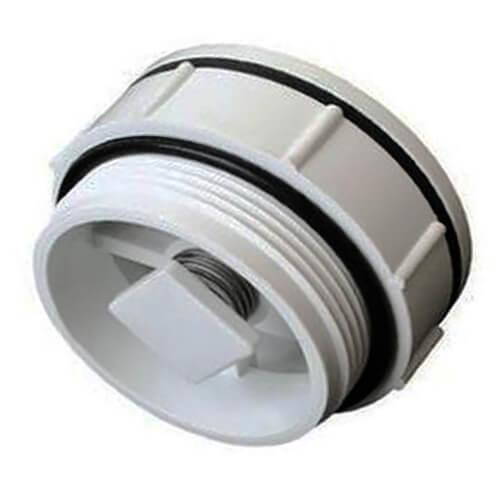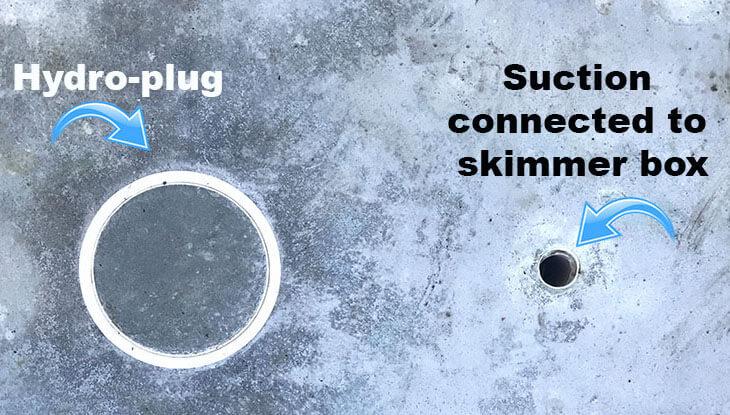
Local Pool Renovations
Melbourne's Leading Pool Renovators
Tiling - Painting - Resurfacing

Melbourne's Leading Pool Renovators
Tiling - Painting - Resurfacing
The white lid at the bottom of the pool is known as a maindrain, here you'll find a detailed explanation of the hydro-static valve.

Hydro-static Valve
A hydrostatic valve is a pressure relief one-way valve or “plug” installed usually at the deepest point of a swimming pool.
The valve usually comes in two sizes: 40mm & 50mm
A valve removal tool is normally needed to remove it.
Without a Hydrostatic valve styled relief from hydrostatic pressure, a swimming pool may be susceptible to the pressure and "pop" or lift out of the ground, in concrete pools it is less likely to lift but can be prone to cracking concrete by the added hydrostatic pressure.
Usually it is at the deepest point of the pool floor, the valve is located under the lid which sits at the bottom of the pool covering the main-drain.
Also known as a Hydro-valve it prevents ground-water pressure from raising the pool or causing movement.
The hydrostatic valve prevents this by allowing ground-water from your surrounding yard to flow into the pool and relieve the pressure on the pool structure.
A build-up of ground water can apply surprising amounts of hydraulic pressure on structures such as swimming pools.
Dirty water in the pool or a slight overflow can be the result of the excess pressure, which is a good sign the valve is working.
Yes, it is necessary to remove the hydrostatic valve when the pool is empty in case it is not working and a new valve must be installed prior to re-filling.
It can vary depending on location, pool structure & other factors, there is no way to determine exact chances or percentage of pools raising.
Scenarios may vary, and can be dependant of having a one way valve relief system that is or isn’t working.
For example:
If your pool is located at higher altitude on top of a small hill, the chances of movement by ground water pressure may be a lot smaller than the exact same pool if it were installed at the bottom of a valley.
This is because ground water tends to move deep into the ground and may be more abundant at the bottom of a hill than at the top.
A similar rule may apply if your pool is located in front of a beach, the chances of movement may be higher than a pool situated in a suburb much further away from the shore.
Also known as a Hydro-valve it prevents ground-water pressure from raising the pool or causing movement.
The hydrostatic valve prevents this by allowing ground-water from your surrounding yard to flow into the pool and relieve the pressure on the pool structure.
Local Pool Renovations encourages you to hire the help of a pool professional.
However, if you have emptied your pool, you may want to remove the hydro-valve as soon as possible, most times the valve is hard to remove by hand.
You can use a hydro valve removal tool, usually available for hire at your Local Pool Shop, all you need to do is figure out if you need a 40mm or 50mm removal tool, otherwise you will end up hiring both.
Hydro-valve Removal tutorial

Hydro-valve Removal tool
Vinyl & fibreglass pools have a greater chance of lifting or shifting because these structures weigh less and therefore it would take less ground water pressure to cause movement.
Fibreglass pools in particular have been known to have the floor “popping up” once empty.
Concrete pools are less likely to shift or raise, because it is a steel reinforced concrete structure that weighs a considerable amount more than any other pool build.
The important thing to remember is that all pools have a tolerance and all pools can and might move, empty or not.
There is no general rule that can answer this question, so many factors come into play that it makes it difficult to answer, and the only problem with having an empty pool is that it increases the likelihood of movement that may cause problems, refer to the above what are the chances of a swimming pool moving.
It is recommended that hydrostatic valves be changed on average every 6/7 years, as the rubber seals may deteriorate over time due to corrosion from pool chemicals.
Not all pools have a hydrostatic valve.
However most swimming pools do usually have some kind of pressure relief system in place.
Older pools may have a similar version of the valve known as a hydro-plug, which also acts as a pressure relief system. A hydro-plug usually looks like a plastic white rim around the size of a dinner plate located at the bottom of the pool, Inside the rim it usually has the same render as the rest of the pool interior.
The majority of swimming pools do have a plastic/pvc hydro-valve and main-drain.
Some pools have a main-drain but find that inside they have a copper fitting instead of a hydro valve, this copper usually oxidezes very quickly, is almost impossible to remove & renders the fitting useless. It's best to remove this fitting without causing damage or install a new main-drain and pressure relief system.
Inside of the Hydro plug is a rendered surface within the rim, this is the part that would pop up to allow excess water pressure into the pool.
On the swimming pool floor next to the hydro-plug is another "pipe" this is typically a second suction point for your skimmer box & serves two purposes:
Yes, we recommend that the Hydro-plug be removed & have a new main-drain installed with the Hydro-static valve system.
This would essentially be more a reliable system and also modernize your swimming pool.
The best time to do this would be during a swimming pool renovation.

This photo shows the Hydro plug and a secondary suction connected to the skimmer box, the surface is a deteriorated marblesheen render.
When changing the hydrostatic valve it is also a good opportunity to replace the pool water, Pool water is treated with strong chemicals, and has biological remains such as oils, dead skin and so forth… Swimming Pool water can no longer be effectively treated after an estimated 6-7 years.
The above information is provided purely for informative purposes, the explanations and information above are from a collection of personal experiences and researched data. LPR do not claim to be engineers and cannot guarantee the accuracy of the information provided. This information is not supplied for anyone within the pool industry to use as a reference or guide.
LPR does not recommend having a pool empty, especially for long periods of time.
Local Pool Renovations does not encourage anyone to “Do it yourself”.
Liability for any resulting consequence of action weighs solely on the pool owner as we encourage pool owners to hire swimming pool professionals. LPR does not accept any legal liability for “problems or damage” that may result from work being performed by you or hired staff outside of LPR employment. Pool owners may be breaching their contractual obligation or voiding their warranty by emptying the pool without first advising their former pool builder or renovation specialist.